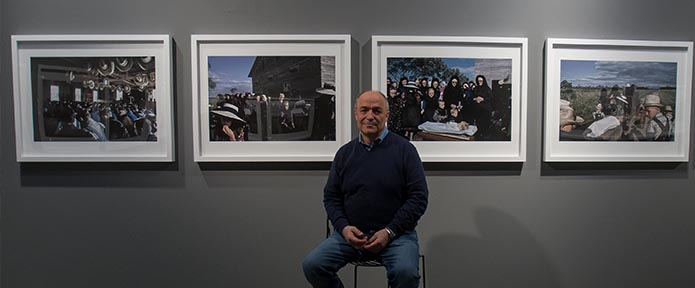20181017
Miguel Bergasa: "In the Mennonite community of Nueva Durago I have the feeling of going back in time".
The artist from Pamplona has presented the exhibition "Mennonites of Nueva Durango", which brings together 40 photographs shown for the first time in color.

Miguel Bergasa (Pamplona, 1951) has undertaken four journeys through time in the last thirty years, the four visits he has made to the Mennonite colony of Nueva Durango, in Paraguay. The artist has presented this Wednesday at the University of Navarra Museum the exhibition Mennonites of Nueva Durangowhich portrays the way of life of this religious community that lives anchored in the sixteenth century. In the presentation he has been accompanied by Rafael Levenfeld, director artistic of the Museum, who has highlighted the "magic eye" of the artist "who sees beyond what many people are capable".
The sample, produced by the Museum, gathers 40 photographs that show different scenes of the life of this colony in their homes, in the countryside, at high school and traveling the roads of the area with their wagons. Scenes in the church are left out of the camera, as he was not allowed to take pictures inside. exhibition The screening of the documentary film Una patria lejos del mundo. Menonitas de Paraguay (1988), which he made with the cameraman Enrique Urdánoz and the journalist Alicia G. Montano. It was broadcasted in the program Documentos TV of Televisión Española.
"I have the feeling of traveling back in time," explained Bergasa. He also detailed some aspects of the austere and monotonous life of the colony. The Mennonites belong to a Christian current that emerged after the religious split led by the Anabaptist bishop Menno Simons - from whom they take their name - in the 16th century, during the Lutheran Reformation in Europe. According to their principles, sin is found in progress, so they renounce all kinds of comforts of the present time.
Their history began in Holland, Switzerland and Germany, from where they left for Russia and from there they fled to the United States and Canada. They are currently established in small colonies in Mexico, Belize, Bolivia and Paraguay. "In the countries where they settle they negotiate three privileges with the governments: not to perform military service, to keep their language (Deitsch, an old dialect of German) and their schools of teaching, where they read the Bible, the only book they have access to."
Bergasa has explained that, in addition to obtaining permission from the head of the colony, he had the support of one of its members Jacob Wall, thanks to whom he was able to gain access to the interior of Mennonite homes. This man was expelled from the colony for his progressive ideas and currently lives near Asunción, capital of Paraguay. "He lives like us, with WhatsApp, Facebook... I have contact with him. I would have liked him to be here because this work without his financial aid would have been very difficult", values the artist.
On the sample, the artist has also explained the challenge that has meant standardizing different photographic supports, from the slides with which he worked at the beginning of project to the current digital support. Thus, the images are shown in the same way and there are no temporal identifications.
Other activities related to the sample have been programmed. This Friday, at 11:45 a.m., there will be a guided tour of visit by the artist accompanied by journalist and writer Javier Reverte. At the end, Reverte will give a lecture, Viajar para contarlo, in which he will share his experience as a traveler and storyteller to purpose of this exhibition. In addition, on Saturday 27, from 10:30 a.m. to 1 p.m., there will be a children's workshop, My first trip, aimed at children between 6 and 11 years old. The price is 6 euros.
The Museum has also published a catalog of the exhibition (80 pages, 24 euros) in which the works are shown and the artist himself writes a travel notebook in which he tells the story of the four visits he made to the colony. It also includes a text by journalist Alicia Gómez Montano.

